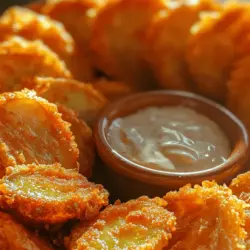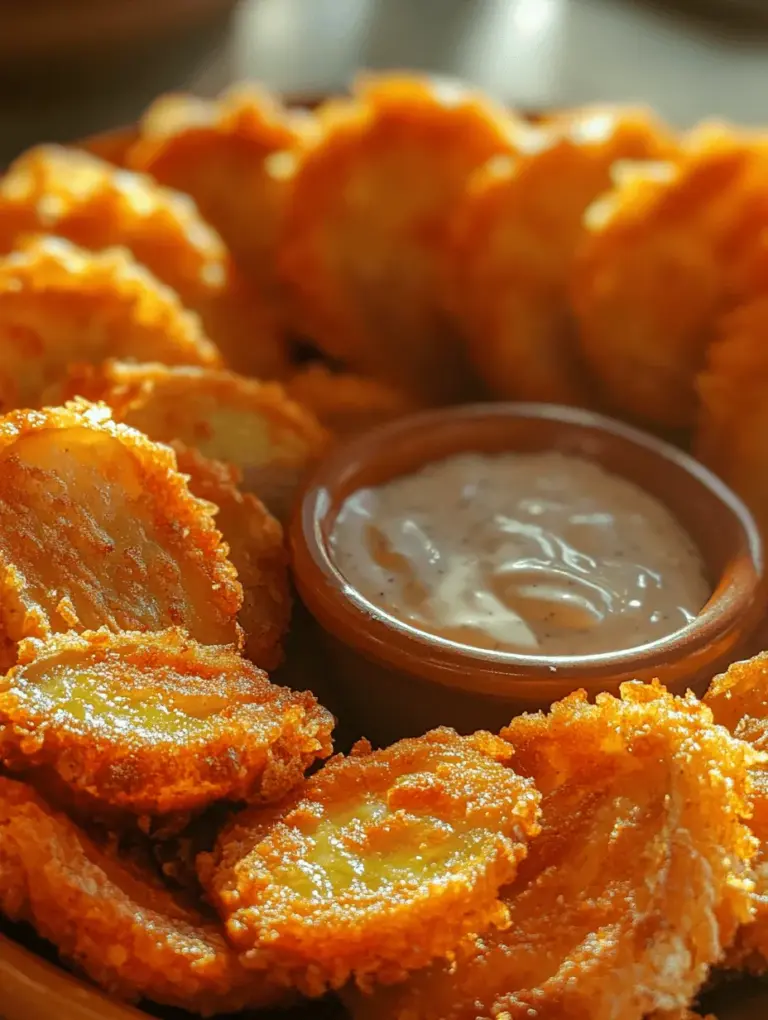Introduction
Fried pickles have become a beloved snack and appetizer across the United States, particularly in the southern regions. These crispy treats offer a delightful combination of tangy and savory flavors that can elevate any gathering, whether it’s a casual family dinner or a lively party. Among the myriad of fried pickle recipes, crunchy zesty fried pickles stand out for their unique flavor profile, which balances the briny essence of dill pickles with a spicy kick and a satisfying crunch.
Making fried pickles at home not only allows you to customize the flavor to your liking but also guarantees freshness that store-bought varieties simply can’t match. The satisfaction of biting into a perfectly crispy, golden-brown pickle, with its zesty interior bursting with flavor, is an experience that every fried pickle lover should indulge in.
The Appeal of Fried Pickles
Fried pickles hold a special place in Southern cuisine, where they originated as a creative way to preserve the freshness of pickled cucumbers. Traditionally served as a side dish or appetizer, these crispy morsels have a rich history that reflects the resourcefulness of Southern cooks. In recent years, the popularity of fried pickles has surged beyond regional borders, making their way into restaurants and bars across the country. From upscale dining establishments to local pubs, fried pickles are now a staple on many menus, often served with a variety of dipping sauces that enhance their flavor.
The versatility of fried pickles makes them an ideal addition to social gatherings. Whether you are hosting a backyard barbecue, a game day party, or simply enjoying a night in with friends, fried pickles can easily cater to a range of palates. Their crunchy texture and zesty flavor appeal to both casual snackers and gourmet food lovers alike, making them a perfect finger food for any occasion.
Ingredients Overview
Creating the perfect crunchy zesty fried pickles requires a few essential ingredients, each playing a crucial role in achieving the desired taste and texture. Below is a detailed description of these ingredients and their contributions to the recipe:
– Dill Pickle Slices: The star ingredient of this dish, dill pickle slices provide that iconic tangy flavor. When fried, they become irresistibly crunchy on the outside while retaining their zesty essence within. For the best results, choose high-quality dill pickles; the fresher the pickles, the better the outcome.
– Buttermilk: This ingredient is key for marinating the pickle slices, helping to tenderize them and infuse flavor. The acidity of buttermilk also aids in creating a crispier coating when frying. If you don’t have buttermilk on hand, you can create a substitute by mixing regular milk with a splash of vinegar or lemon juice, letting it sit for a few minutes to curdle.
– All-Purpose Flour: Flour serves as the base for the coating, providing a sturdy foundation that adheres to the pickles during frying. It helps create a light and crispy texture that is essential for the ultimate fried pickle experience.
– Cornmeal: Adding cornmeal into the batter not only enhances the crunch but also contributes a slightly sweet, corny flavor that complements the brininess of the pickles. The combination of flour and cornmeal provides a delightful contrast in texture that elevates the overall dish.
– Spices (Garlic Powder, Onion Powder, Paprika, Cayenne Pepper): These spices are critical for enhancing the flavor of the fried pickles. Garlic powder and onion powder add depth and savoriness, while paprika contributes a mild smokiness. For those who enjoy a bit of heat, cayenne pepper can be adjusted to taste, allowing you to customize the spice level to your preference.
– Oil Types for Frying: The choice of oil is crucial for achieving the desired crispiness of the fried pickles. Oils with a high smoke point, such as vegetable oil, canola oil, or peanut oil, are ideal for frying. They allow for a rapid cooking process that ensures the pickles become golden brown and crunchy without absorbing too much oil.
Preparation Steps for Crunchy Zesty Fried Pickles
To create the perfect crunchy zesty fried pickles, follow these step-by-step preparation instructions. One of the most important aspects of making fried pickles is ensuring that the pickle slices are adequately drained and dried before they are battered. This step is essential for optimal batter adherence and achieving that coveted crunchiness.
1. Drain the Pickles: Begin by removing the dill pickle slices from their jar and placing them in a colander to drain. This will help remove excess moisture that could prevent the batter from sticking properly.
2. Dry the Pickles: Once drained, use paper towels to pat the pickle slices dry. This step is crucial because any residual moisture can lead to a soggy coating, which is not desirable for fried pickles.
3. Marinate in Buttermilk: Place the dried pickle slices in a bowl and pour buttermilk over them, ensuring they are fully submerged. Allow the pickles to marinate for at least 30 minutes. This will enhance their flavor and prepare them for the frying process.
4. Prepare the Battering Mixture: In a separate bowl, combine the all-purpose flour, cornmeal, and your chosen spices (garlic powder, onion powder, paprika, and cayenne pepper). Mix well to ensure that the spices are evenly distributed throughout the batter.
5. Coat the Pickles: After the pickles have marinated, remove them from the buttermilk, allowing any excess to drip off before coating them. Dredge each pickle slice in the batter mixture, ensuring that they are evenly coated. Shake off any excess batter to prevent clumping during frying.
6. Heat the Oil: In a large skillet or deep fryer, heat your chosen oil over medium-high heat. To test if the oil is hot enough, drop a small amount of batter into the oil; it should sizzle and rise to the surface immediately.
The preparation of crunchy zesty fried pickles is just the beginning. The next steps will guide you through the frying process, ensuring that your pickles come out perfectly crispy and delicious. Stay tuned for the continuation of this flavorful journey!
{{image_1}}
Explanation of the Marination Process and Its Benefits
Marinating the pickles is a crucial step that enhances their flavor profile and contributes to a more enjoyable eating experience. The process involves soaking the pickles in a seasoned liquid, typically composed of vinegar, spices, and sometimes a hint of sugar. This not only adds a zesty kick to the pickles but also helps to firm up the texture, ensuring they hold up well during frying.
The benefits of marination are twofold. First, it infuses the pickles with a deeper flavor, making each bite more satisfying. Second, the acidity from the vinegar helps to break down the pickles’ cellular structure slightly, leading to a crunchier texture after frying. To achieve the best results, let the pickles marinate for at least 30 minutes, although longer (up to a few hours) can yield even better flavor absorption.
Detailed Guide for Mixing the Dry Ingredients and Achieving an Even Coating
The dry coating is essential for achieving that signature crunch when frying pickles. To create the perfect batter, gather the following dry ingredients:
– 1 cup all-purpose flour
– 1 cup cornmeal
– 1 teaspoon garlic powder
– 1 teaspoon onion powder
– 1 teaspoon smoked paprika
– ½ teaspoon cayenne pepper (adjust to taste)
– Salt and pepper to taste
In a large mixing bowl, combine the flour and cornmeal first. The combination of these two ingredients provides a delightful crunch and a robust base. Next, add the garlic powder, onion powder, smoked paprika, cayenne pepper, and a sprinkle of salt and pepper. Mix thoroughly to ensure all the spices are evenly distributed throughout the flour and cornmeal mixture.
To achieve a consistent coating on each pickle slice, it’s essential to dredge them properly. First, use a fork or tongs to remove the pickles from their marinade, allowing any excess liquid to drip off. Then, dip each pickle slice into the dry mixture, ensuring it is completely covered. Shake off any excess coating before placing it on a separate plate. This step is crucial; too much coating can lead to a thick, soggy crust instead of a light, crispy one.
Tips on Checking Oil Temperature for Ideal Frying Conditions
Oil temperature is vital for achieving perfectly fried pickles. If the oil is too cold, the pickles will absorb excess oil, becoming greasy rather than crispy. Conversely, if the oil is too hot, the exterior may burn before the inside is adequately cooked.
To check the oil temperature, use a kitchen thermometer. Ideally, the oil should be heated to around 350°F (175°C). If you don’t have a thermometer, you can perform a simple test: drop a small amount of the dry mixture into the oil. If it sizzles and rises to the surface, the oil is ready. If it sinks without sizzling, the oil is not hot enough; if it browns too quickly, it’s too hot.
Methodical Approach to Coating and Frying the Pickles for Perfect Texture
Once your pickles are well-coated and the oil is perfectly heated, it’s time to fry. Carefully add the coated pickles to the hot oil in small batches. Overcrowding the pan can lower the oil temperature and lead to uneven cooking. A good rule of thumb is to fry no more than 6-8 pickle slices at a time, depending on the size of your pan.
Fry the pickles for about 2-3 minutes on each side or until they achieve a beautiful golden-brown color. Use a slotted spoon to carefully flip them halfway through. Once cooked, transfer the fried pickles to a plate lined with paper towels to absorb any excess oil. This step is crucial to maintain their crispiness.
Frying Techniques for Perfectly Crispy Pickles
When it comes to frying methods, you can choose between deep frying and shallow frying.
– Deep Frying: This method involves submerging the pickles entirely in hot oil, which allows for even cooking and a consistently crispy texture. Deep frying is ideal for achieving that classic golden-brown crust quickly.
– Shallow Frying: This technique uses less oil, which can be a healthier option. However, it requires more attention to ensure that the pickles are flipped regularly to achieve an even crisp. This method may also result in slightly less crunch, but it can still yield delicious results.
Regardless of the method chosen, maintaining the correct oil temperature is crucial. Additionally, frying in small batches ensures that each pickle receives adequate space and heat for perfect cooking.
Tips for Achieving the Perfect Golden-Brown Color Without Burning
To achieve that perfect golden-brown color, keep an eye on the frying process. Start by frying the pickles for 2-3 minutes, but do not walk away. As soon as they start to turn golden, it’s time to flip them. If you notice that they are darkening too quickly, reduce the heat slightly to prevent burning.
Once removed from the oil, allow the pickles to cool on a paper towel-lined plate. This not only absorbs excess oil but also allows the crust to set, enhancing the crunchiness as they cool.
Serving Suggestions for Fried Pickles
Fried pickles are delicious on their own, but they can also be elevated with a variety of dipping sauces and creative serving ideas.
Dipping Sauces: The classic pairing for fried pickles is ranch dressing, which provides a creamy contrast to the crunchy texture. For those looking for something with a kick, try a spicy sriracha mayo or a tangy dill dip. You could also consider a homemade spicy mustard for a zesty alternative.
Creative Serving Options: Fried pickles can be incorporated into various dishes. For example, try adding them to burgers for an extra layer of flavor and crunch. They can also be chopped and tossed into salads for a unique twist, adding texture and a burst of flavor.
Garnishing and Presentation: To elevate the presentation, serve your fried pickles on a wooden board or in a rustic basket lined with parchment paper. Garnish with fresh herbs, such as parsley or dill, for a pop of color. Additionally, consider serving with lemon wedges to add a fresh zing when squeezed on top.
Nutritional Information
Understanding the nutritional content of your fried pickles can help you enjoy them mindfully. A standard serving of fried pickles (approximately 4-5 slices) typically contains:
– Calories: 200-300
– Total Fat: 12-18 grams
– Saturated Fat: 2-4 grams
– Carbohydrates: 25-35 grams
– Protein: 3-5 grams
– Fiber: 1-2 grams
While fried foods can be indulgent, moderation is key. Enjoy your fried pickles as an occasional treat rather than a staple in your diet. If you are looking for healthier alternatives, consider using gluten-free flour and cornmeal for a gluten-free option or air frying instead of deep frying to reduce oil content significantly.
Conclusion
Making crunchy zesty fried pickles is a delightful culinary adventure that results in a snack that is both satisfying and flavorful. With the right marination, a well-mixed dry coating, and proper frying techniques, you can create a mouthwatering dish perfect for any occasion.
Don’t hesitate to experiment with your variations of this recipe to suit your taste preferences, whether that’s adjusting the spice levels or trying different dipping sauces. The joy of sharing homemade snacks with friends and family is immeasurable, and fried pickles are sure to be a hit at your next gathering. So gather your ingredients, prepare your pickles, and indulge in the crispy, zesty delight that is homemade fried pickles!


